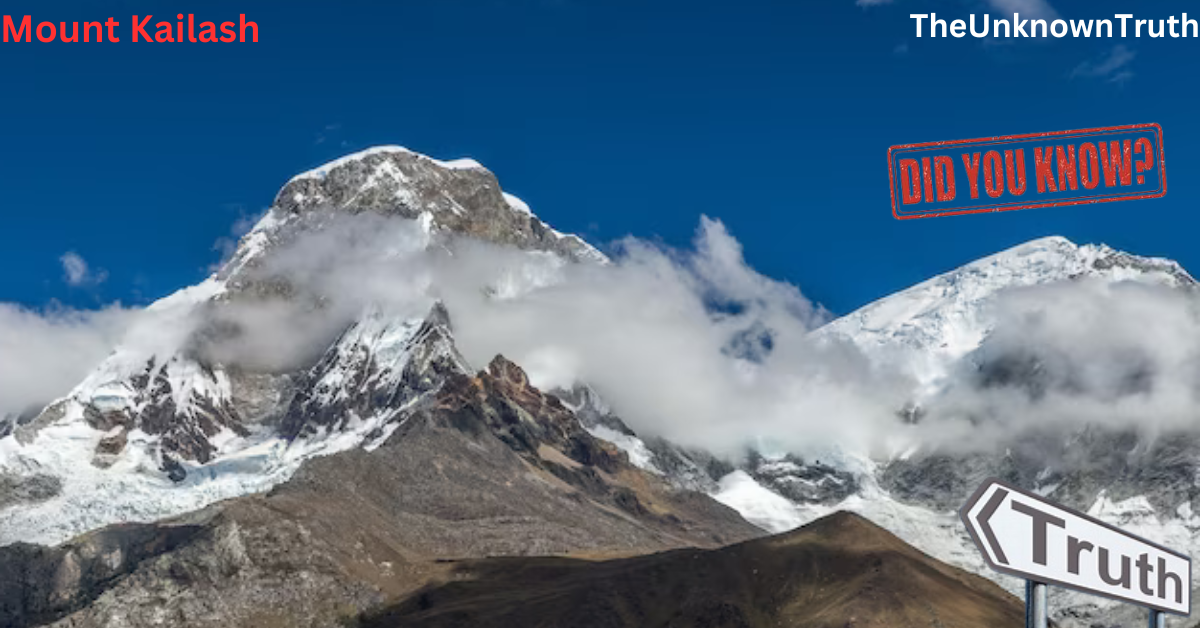Nestled in the remote corners of the Tibetan Plateau, Mount Kailash stands tall and majestic, holding a significant place in the hearts and minds of millions. This awe-inspiring mountain, revered by multiple religions and considered one of the holiest places on Earth, has been shrouded in mystery and spirituality for centuries. In this blog post, we embark on a journey to explore the enigmatic Mount Kailash, uncover its mysteries, and delve into some incredible human incidents that have occurred in its vicinity. It is also known as Kailash parbat.
The Sacred Presence of Mount Kailash
Mount Kailash is a part of the Transhimalaya range in Tibet, China, and is known as Kang Rinpoche in Tibetan. It rises to an elevation of 6,638 meters (21,778 feet) and is considered the abode of Lord Shiva in Hinduism, the dwelling place of the Buddha Demchok in Buddhism, and a sacred site for followers of the Bon religion. The mountain’s spiritual significance draws pilgrims from various faiths who undertake arduous journeys to circumambulate it, a ritual known as Kora.
Mysteries Enveloping Mount Kailash
1. Unclimbed Summit: One of the most baffling mysteries surrounding Mount Kailash is the fact that its summit remains unconquered. While numerous mountain climbers have scaled the world’s highest peaks, including Mount Everest, none have dared to attempt the ascent of Kailash. It is believed that doing so would be sacrilegious and against the sacred nature of the mountain.
2. Anti-Clockwise Circumambulation: Another intriguing aspect of Mount Kailash is the ritual of circumambulating the mountain in an anti-clockwise direction. Most sacred sites and temples call for clockwise circumambulation, but Kailash is an exception. The reason behind this tradition remains a mystery, though it is deeply ingrained in the beliefs of pilgrims.
3. Perpetually Unmelting Snow: Despite its harsh weather conditions, the snow on Mount Kailash is said to never melt. This peculiar phenomenon has led to various speculations, including the belief that it is the spiritual energy of the mountain that keeps the snow perpetually frozen.
4. The Mysterious ‘Swastika’ Formation: Aerial photographs of the surrounding area have revealed an uncanny swastika-like formation of two rivers and two lakes near Kailash parbat. This unique geological feature has perplexed scientists and spiritualists alike. Some view it as a symbol of auspiciousness, while others seek to decipher its deeper meaning.
Human Incidents and Extraordinary Encounters
1. The Tale of Milarepa: Milarepa, a renowned Tibetan yogi and poet, is said to have meditated in the caves near Mount Kailash. His life story, filled with hardships and redemption, continues to inspire spiritual seekers. His connection to the mountain is considered a testament to the profound spiritual energy of Kailash.
2. The Disappearance of Maurice Herzog’s Team: In 1950, French climber Maurice Herzog led an expedition to explore the Himalayas, including Kailash. While they didn’t attempt to climb Kailash, his team faced extreme challenges and encountered numerous hardships during their journey. The expedition’s hardships and Herzog’s later disappearance while exploring the region added an element of mystery to the mountain.
3. The Kora Pilgrimage: Every year, thousands of pilgrims embark on the Kora around Kailash parbat. Some report encountering supernatural phenomena, while others find spiritual enlightenment during their journey. These personal accounts add layers of mysticism to the already enigmatic mountain.
4. The Shambhala Connection: Kailash parbat has been associated with the mythical kingdom of Shambhala, a hidden utopia believed to be a source of spiritual wisdom and enlightenment. Many spiritual seekers and explorers have ventured into the region in search of this legendary realm, adding to the mountain’s aura of mystery.
FAQs about Kailash parbat
Q1: Is it possible to climb Mount Kailash?
No, climbing Mount Kailash is strictly prohibited and considered sacrilegious by followers of Hinduism, Buddhism, and the Bon religion. The mountain is revered as a sacred place and is meant for circumambulation or meditation, not for climbing.
Q2: Can anyone visit Mount Kailash?
Yes, Mount Kailash is open to tourists, but visiting the region requires a special permit due to its remote location in Tibet, China. Pilgrims from various religions and spiritual backgrounds visit Kailash to engage in the Kora or simply to experience its unique energy.
Q3: Why is the snow on Mount Kailash said to never melt?
The perpetually unmelting snow on this mountain is often attributed to its spiritual energy. Many believe that the mountain’s divine presence keeps the snow frozen year-round, adding to its mystique.
Q4: Is it safe to undertake the Kora pilgrimage around Mount Kailash?
While the Kora pilgrimage is a physically demanding journey due to high altitudes and harsh weather conditions, it is generally considered safe for those who are physically prepared. Pilgrims should take necessary precautions, such as acclimatization and proper gear, to ensure their safety.
Conclusion
Mount Kailash remains an enduring symbol of spirituality, mystery, and wonder. Its towering presence and the enigmatic experiences of those who journey to its slopes continue to capture the imagination of people worldwide. Whether you seek spiritual enlightenment, adventure, or simply the chance to witness the marvels of nature, Kailash parbat offers an unparalleled experience that transcends the ordinary and leaves an indelible mark on the human soul. It is a testament to the enduring power of the natural world to inspire and mystify us, reminding us of the profound connection between humanity and the Earth.
So, when the opportunity arises, consider embarking on a journey to this sacred mountain, where you can unravel its mysteries and perhaps find your own spiritual awakening amidst the breathtaking beauty of Mount Kailash.

1 thought on “Unveiling the Mysteries of Mount Kailash: A Sacred Journey”